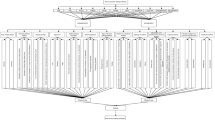Abstract
Optimal design of irrigation channels has an important role in planning and management of irrigation projects. The input parameters used in design of irrigation channels are prone to uncertainty and may result in failure of channels. To improve the overall reliability and cost effectiveness, optimal design of composite channels is performed as a chance constrained problem in this study. The models are developed to minimize the total cost, while satisfying the specified probability of the channel capacity being greater than the design flow. The formulated model leads to a highly non-linear and non-convex optimization problem having multimodal behavior. In this paper, the usefulness of two meta-heuristic search algorithms such as Genetic Algorithms (GA) and Particle Swarm Optimization (PSO) are investigated to obtain the optimal solutions. Two site specific cases of restricted top width and restricted flow depth are also analyzed. It is found that both the algorithms performing quite well in giving optimal solutions and handling the additional constraints.
Similar content being viewed by others
References
Balter AM, Fontane DG (2008) Use of multi-objective particle swarm optimization in water resources management. J Water Resour Plan Manage 134(3):257–265
Bhattacharjya RK (2006) Optimal design of open channel section incorporating critical flow condition. J Irrig Drain Eng 2(5):513–518
Bhattacharjya RK, Satish MG (2008) Flooding probability based optimal design of trapezoidal open channel using freeboard as design variable. J Irrig Drain Eng 134(3):405–408
Chow VT (1959) Open channel hydraulics. Mc-Graw Hill, New York
Chow VT, Maidment DR, Mays LW (1988) Applied hydrology. Mc-Graw Hill, Singapore
Das A (2000) Optimal channel cross section with composite roughness. J Irrig Drain Eng 126(1):68–72
Das A (2007) Flooding probability constrained optimal design of trapezoidal channels. J Irrig Drain Eng 133(1):53–60
Das A (2008) Chance constrained optimal design of trapezoidal canals. J Water Resour Plan Manage 134(3):310–313
Deb K (2001) Multi-objective optimization using evolutionary algorithms. Wiley, Chichester
Easa SM (1992) Probabilistic design of open channels. J Irrig Drain Eng 118(6):868–881
Easa SM (1994) Reliability analysis of open drainage channels under multiple failure modes. J Irrig Drain Eng 120(6):1007–1024
Froehlich DC (1994) Width and depth constrained best trapezoidal section. J Irrig Drain Eng 120(4):828–835
Goldberg DE (1989) Genetic algorithms in search, optimization, and machine learning. Wiley, Reading
Gould NIM, Orban D, Toint PL (2005) Numerical methods for large-scale nonlinear optimization. Acta Numerica 14:299–361. doi:10.1017/S0962492904000248
Guo CY, Hughes WC (1984) Optimal channel cross section with freeboard. J Irrig Drain Eng 110(3):304–314
Holland JH (1975) Adaptation in natural and artificial systems. University of Michigan Press, Ann Arbour
Horton RE (1933) Separate roughness coefficients for channel bottom and sides. Eng News-Rec 111(22):652–653
Jain A, Bhattacharya RK, Sanaga S (2004) Optimal design of composite channels using Genetic Algorithm. J Irrig Drain Eng 130(4):286–295
Janga Reddy M, Nagesh Kumar D (2006) Optimal reservoir operation using multi objective evolutionary algorithm. Water Resour Manag 20(6):861–878
Janga Reddy M, Nagesh Kumar D (2007) Optimal reservoir operation for irrigation of multiple crops using elitist mutated particle swarm optimization. Hydrol Sci J 52(4):686–701
Janga Reddy M, Nagesh Kumar D (2009) Performance evaluation of elitist-mutated multi-objective particle swarm optimization for integrated water resources management. J Hydroinform 11(1):78–88
Jung BS, Karney BW (2006) Hydraulic optimization of transient protection devices using GA and PSO approaches. J Water Resour Plan Manage 132(1):44–52
Kennedy J, Eberhart RC (1995) Particle swarm optimization. Proc IEEE Int Conf Neural Netw 14:1942–1948
Lee HL, Mays LW (1986) Hydraulic uncertainties in flood levee capacity. J Hydraul Eng 112(10):928–934
Loganathan GV (1991) Optimal design of parabolic channels. J Irrig Drain Eng 117(5):716–735
Mohan S, Vijayalakshmi DP (2008) Estimation of Nash’s IUH parameters using stochastic search algorithms. Hydrol Process 22:3507–3522
Monadjemi P (1994) General formulations of best hydraulic channel sections. J Irrig Drain Eng 120(1):27–35
Montalvo I, Isquierdo J, Perez R, Tung MM (2008) Particle swarm optimization applied to the design of water supply systems. Comp Math Appl 56(3):769–776
Nagesh Kumar D, Janga Reddy M (2007) Multi purpose reservoir operation using particle swarm optimization. J Water Resour Plan Manage 133(3):192–201
Oliveira R, Loucks DP (1997) Operating rules for multi reservoir systems. Water Resour Res 33(4):839–852
Poli R (2008) Analysis of publications on the applications of Particle Swarm Optimization. J Artif Evol Appl 2008:1–10. doi:10.1155/2008/685175
Savic DA, Walters GA (1997) Genetic Algorithms for least cost design of water distribution networks. J Water Resour Plan Manage 123(2):67–77
Suribabu C, Neelakantan T (2006) Design of water distribution networks using particle swarm optimization. Urban Water 3(2):111–120
Trout TJ (1982) Channel design to minimize lining material costs. J Irrig Drain Eng 108(4):242–249
Tung YK, Mays LW (1980) Risk analysis for hydraulic design. J Hydraul Div 106(HY5):893–913
Wang QJ (1991) The genetic algorithm and its application to calibrating conceptual rainfall runoff models. Water Resour Res 27(9):246–271
Wardlaw R, Sharif M (1999) Evaluation of genetic algorithms for optimal reservoir system operation. J Water Resour Plan Manage 125(1):25–33
Author information
Authors and Affiliations
Corresponding author
Rights and permissions
About this article
Cite this article
Janga Reddy, M., Adarsh, S. Chance Constrained Optimal Design of Composite Channels Using Meta-Heuristic Techniques. Water Resour Manage 24, 2221–2235 (2010). https://doi.org/10.1007/s11269-009-9548-5
Received:
Accepted:
Published:
Issue Date:
DOI: https://doi.org/10.1007/s11269-009-9548-5




